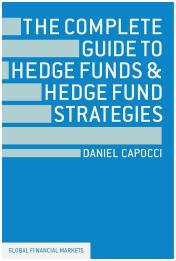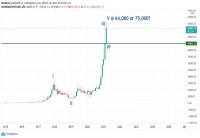|

Daniel Capocci
Daniel Capocci, senior investment manager and in charge of absolute return UCITS investments at Architas Multi-Manager, the dedicated multi-manager arm for retail products at AXA, gives us some feedback on where he sees advantages and flaws investing in UCITS. Daniel has experience in investing in hedge funds since 2001, first as an offshore investor and more recently as a UCITS one. Daniel is the author of The Complete Guide to Hedge Funds & Hedge Fund Strategies published by Palgrave McMillan last August. 552 pages covering all aspects of the hedge fund industry from its origins and basics to the details of more than 20 investment strategies all illustrated thanks to over 220 figures, 40 practical examples and over 80 tables. Daniel, what is your universe of investments? In terms of asset classes, our investment universe is very broad. I can't say unlimited but there is no formal constraint on what we can invest in. The only limitations come from the investment managers' interest and speciality, and more importantly the structure of the product that has to either be UCITS or closed ended investment funds. And for what types of investors? Architas is part of the AXA Group and fully owned by AXA. There are two sides to the business: an established UK business and a growing European business. In the UK, Architas has been active in the market and working with IFAs for many years. In Europe, the situation is different: we work solely with entities of the AXA Group. This explains why we have to focus almost exclusively on UCITS funds. What are your constraints? Size of the fund? Brand names? Strategies? There are no formal rules, but we need to balance all of these factors and ensure that the end result is appropriate for the client. As a portfolio manager you have to bear in mind that your ultimate client is a retail client. For example,when it comes to the size of the fund, we will not invest in a very small fund - typically one with less than €50 million in assets. We can consider funds between €50 and €100 million but will rarely invest in these unless we expect the fund to grow rapidly from there or if the manager has larger funds and/or existing offshore funds with a larger asset base. The world has changed over the last decade: even in the hedge fund world, there is not a lot of room for very small players anymore. Today, brand is an important element for certain distribution channels, particularly in Europe. A strong brand leads to more confidence and this may to be integrated in portfolio construction. It is an interesting topic because when you work in the retail landscape, the well-known brands are the classic large asset managers, while alternative asset managers, even the largest and biggest names in the hedge fund world, remain completely unknown. While this will probably change over time, it has not yet, despite the emergence of NEWCITS and the success of some products. Regarding strategies, alternative strategies are still little known outside of the financial world. Long/short equity and equity market neutral strategies are probably the ones that are the easiest to understand and are the ones currently garnering more interest. This is chiefly because traditional long only houses have started adding new funds that incorporate such strategies to their proposition. Most other strategies, however, are still too specific to be considered on a stand-alone basis. The greatest opportunity, I believe, for the growth of alternative UCITS in the retail world lies in their being used as diversifiers of multi-asset portfolios. All in all, our role as portfolio managers in 2013 is to combine classic and alternative strategies;to combine the larger, strong-brand asset managers with smaller, less known fund managers; and to consider less known or more complicated strategies in order to offer the desired return profile in a portfolio context. How specific is a Due Diligence process on UCITS? On the investment side, the due diligence is exactly the same as in the offshore world. As a potential investor, you want to understand the objective of the fund, the strategy, how it is implemented, the tools available, the securities used, the constraints and the potential sources of risk. In short, you want to understand what the manager is doing and how he or she is trying to make money. 
There are, however, a few elements that are specific to UCITS funds. In the first place, there are some additional protections, the main element being that the counter party risk is limited to 10%. This is a real plus. Furthermore, there are the commonly called 5-10-40 rules that limit the size of the largest single position to 10%and all positions over 5% to add up to less than 40% of NAV. There is also the VaR approach that puts a limit on the global level of risk for alternative UCITS portfolios, though the legal limit remains very high. Alongside this, there is an additional and specific element that has to be analysed and understood: specifically, that UCITS funds cannot short cash equities, but rather short positions have to be implemented through derivatives, and the structure can be very different from one fund to another. In some cases, each position is swapped individually; in others, all the shorts are combined in one security; and in yet others, the whole portfolio is swapped. These structures are not always easy to understand and, more importantly, the inherent costs are not always fully transparent. In addition, as in any swap transaction, there is collateral to be used in case of default but,without any set rules as to what this should be, it is not always as safe as one would expect. This is a new risk that is specific to UCITS and one that has to be understood and incorporated in the process. Where do you see differences between a Long Only fund and a L/S? Management style? Returns? Risk management? Same? For me,the real difference between long only and long/short comes down to the profile of the manager. If you are a great long only manager, you are not necessary a good long/short manager and vice-versa: both need different capabilities. Even if the investment world has evolved over the last few years, the aim in the long only environment is to offer attractive returns versus the market and the asset class you invest in. You typically have to know your market very well but your final objective is to be amongst the best in your specific market without considering the global trend of the market. On the long/short side, however, your market is typically much broader, even in the case of sector funds, simply because of the option to take short positions. Another element is that long/short managers typically have different ways of thinking. When a high conviction idea is implemented by an alternative manager, it may be supported by additional positions which hedge some of the risks the manager does not want to be exposed to and limit the global risk of the portfolio. Large positions are still taken to reflect high convictions, but this is a means of minimizing the risk that the analysis might be wrong. You do not manage relative to an index but relative to your own convictions to create a portfolio with a balanced level of risk. This is not something you will typically see in long only portfolios, where everything is relative to an index: managers take relative bets. Regarding risk management, the main difference for me is that on the long/short side, risk management is part of the management of the fund. A good long/short manager is one that builds a portfolio with a risk level in line with the profile of the fund. This is the aim of absolute return strategies. On the long only side, however, risk management can be more or less stringent,and the relationship between portfolio managers and risk management is not the same as the one of long/short players. When a long only manager takes an underweight in a stock relative to the index, if the stock outperforms, the relative bet will be smaller and the relative level of risk with be lower. For a long/short manager the situation is completely difference. If a portfolio manager takes a short position the size of the short increases will increase if the stock performs well and the level of risk of the portfolio will increase too. This explains why long/short manager have a different relation to risk than long only managers. How to you get access to talents? Databases? Word of mouth? Direct approach from managers? This is one of the key questions. Having analyzed the world of hedge funds for almost 15 years and invested in alternative funds for more than ten years, I have found various ways to identify interesting managers. In brief, it is the amalgamation of many sources including databases, research, words of mouth, being approached directly by managers, sales representatives, UCITS platforms and contacts, as well as more basic sources like web searches. In today's world, the web has become a source of information you cannot neglect. The problem for an investor is not to find managers but to be sure you don't miss the best ones. What do you think of the Risk parity fund? It is an interesting concept and a good idea to formalize what hopefully most managers have taken into account practically in their day-to-day management for decades, to balance risk. The final idea is simply to force the diversification of risk and to continuously do so. However this remains specific to quantitatively managed portfolios. While I think that such a strategy clearly helps to keep the level of risk of the portfolio stable over time, it does not keep the level of opportunities stable over time. I understand the fact that investors like the idea of having have a clearer idea of the level of risk of your portfolio. The issue being that the global level of risk in the markets globally may increase, changing the rules. In addition, a - relatively - stable level of risk does not mean stable returns. This is why such strategies have sense and will help to diversify a portfolio but why as multi-manager investors we need to balance this with active managers looking to create alpha or absolute return in any market conditions. |
|
This article was published in Opalesque UCITS intelligence.
|





 RSS
RSS











